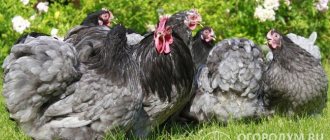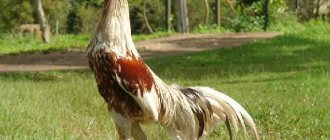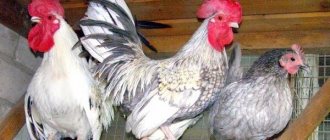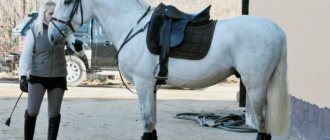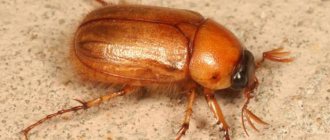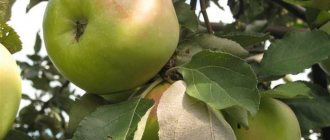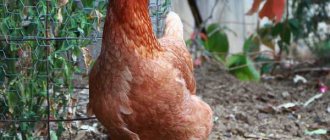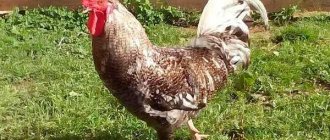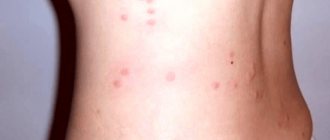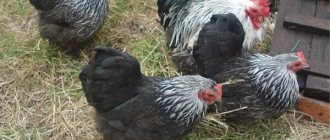The Legbar breed of chickens is not the most popular bird in the yards of Russian people. Nevertheless, many have heard about this chicken, or at least were interested in its eggs. The Legbar is one of those unique breeds whose eggs have colored shells. In this case, the Legbar eggs are colored a rich blue hue.
In today's publication you will learn a detailed description of the breed, see photos of these amazing chickens, and also read reviews from those farmers who were lucky enough to meet a unique bird that lays blue eggs.
Origin story
The breed began its life's journey in 1929 within the walls of the Cambridge Genetic Institute. Two scientists Michael Pease and Reginald Punnett, who were breeders by profession, decided to create a new breed of autosex chickens. An autosex bird is one in which, at one day of age, the characteristics of a male and a female are clearly distinguishable.
Two varieties were selected for work:
- Striped Plymouth Rock (hen).
- Kempinsky rooster.
Thanks to the work carried out, the hatched chicks, already at one day of age, had the distinctive color of cockerels and future laying hens. However, after the offspring grew up, it became clear that egg production was at a fairly low level. As a result, it was decided to continue the experimental work. It was decided to replace the Kempinsky rooster with a Partridge Leghorn (as we know, Leghorns are one of the most productive egg breeds).
A few years later, breeders managed to breed a new bird with good egg production. The first Legbar was named “Golden Legbar” and it was registered in 1945. Later, the “Golden Legbar” was crossed with a white Leghorn, after which a new Legbar was born - “Silver”, this happened in the year 51.
7 years later, at one of the exhibitions they showed a new type of this breed, “Cream Legbar”, which was obtained through the selection of “Silver Legbar”, “White Leghorn” and “Araucan”. A distinctive feature of this chicken was its amazing eggs, the shells of which had a blue tint.
Price
Legbar chicken eggs are more expensive than regular eggs because they have an unusual color. An egg for consumption costs from 25 to 50 rubles, and for incubation – 250 rubles.
Average prices for Legbar birds in Russia:
- A day-old chick can be bought for 300-500 rubles.
- A month-old chick is sold for 600-800 rubles.
- A bird 4 months old can be bought for 1,500 rubles.
- Chickens or roosters older than 10 months are sold for 2800-3200 rubles.
Chicken meat costs the same as any other medium-weight meat breed. 1 carcass can be bought for 250-400 rubles.
Even a novice poultry farmer can keep Legbar chickens. The main thing is to follow all the recommendations of experts and carefully read the description of the breed before purchasing. Photos of adult hens and chicks will help you choose the right breed and not fall for the tricks of unscrupulous sellers who pass off one type of bird as another.
Appearance
Legbar roosters are very powerful birds. The rooster's body shape resembles a wedge. The chest is massive, wide, the back is very long. The tail has a slope of 45 degrees, quite full. The wings are set very tightly. The head is compact, looks harmonious on the body, the comb is erect, 5-6 teeth, colored bright red. Earrings are white.
As for the hens, they have the same leaf-shaped comb as the cockerels. Sometimes the comb falls on its side. The hens have bright orange eyes. The legs are yellow and look rather thin, but are actually quite strong.
The weight of an adult cockerel is 3.5 kg, while laying hens have a body weight of no more than 3 kg, most often 2.5 kg.
The Legbar bird has fairly soft plumage, pleasant to the touch. A distinctive feature of this bird is the presence of a characteristic crest on the head, which is why they are often called crested. There are several varieties of Legbars (this, however, you understood from the introduction above): cream, golden and silver. Today, the most popular variety of all is the cream variety, the one that produces blue eggs.
This is an autosex breed and the differences in day-old chicks by gender are very pronounced.
Future laying hens have a dark stripe on their backs, which starts from the head and runs along the entire back. Cockerels have a light-colored stripe on their backs with a fuzzy structure. In addition, hens have dark plumage, while cockerels have light plumage.
What does a chicken look like?
Klushi look very funny - their round, lush body makes them cute buns that move on short, clumsy legs. But this does not prevent them from maintaining their royal charm.
By the way, speaking of “royal” - instead of a crown, the feathered ladies have a small, lush crest. On the head there is a moderately developed red comb and earrings of the same color. The weight of such a round beauty is up to 3 kg. The feathers are thick, dense and lush.
The back is straight, smoothly turning into a tail. The color of the fluffy “fur coat” comes in two variations – creamy-golden and ash-silver.
It is extremely rare that white representatives are born who inherited this color from their Leghorn forefathers. Such “brides” are not allowed to participate in the breeding process - they are discarded.
Productivity
Legbar is popular not only because the hens produce blue eggs (although its fame is largely due to this), but also because it is a fairly productive egg bird. Legbars have Leghorn blood, which is what caused such high egg production rates. On average, one hen produces about 250 eggs per year.
At home, without quality care and the availability of special feed, you can expect 200-210 eggs per year from a chicken. The egg has a round shape and an average weight of about 60 g.
Nutrition of an adult herd
English women are real gourmets - they will not eat just anything. If you plan to feed the whooping whales with ready-made food, then it is worth purchasing a special mixture. Blue food is specially developed for this species and fully satisfies its nutritional needs.
If you want to prepare your own feed for laying hens, they can tolerate a traditional meat-egg diet.
They, just like everyone else, can eat wet mash with vegetables, root vegetables and cereals for breakfast. Periodically take care of the health of the stomachs in your flock - give the birds fermented milk products.
Winter feeding differs from summer feeding in several nuances.
- Morning mash should be warm.
- The feed rate has been increased by 5-10%.
- High content of vitamins.
- It is recommended to use prepared feed - sprouted or yeasted grain.
- Do not overuse premixes to improve egg productivity, as they impair the absorption of valuable substances from food.
Advantages and disadvantages of poultry
Legbars have a number of advantages, thanks to which farmers who have chosen representatives of this breed remain faithful to them and do not exchange them for other, no less promising hybrids. The main advantages of Legbars include:
- High decorativeness of both the chicken itself and its eggs.
- Precocity. Hens begin to produce eggs at approximately 4 months of age.
- This is a fairly calm and peace-loving bird that is not provoked and very rarely starts conflicts.
- The bird has a fairly strong immune system, which allows it to resist most chicken diseases.
- This is an autosex bird, so chicks can be separated by sex already at day old.
Do they have any disadvantages? Yes, I have. There are few of them, but do not forget about them:
- First of all, chickens lack maternal instinct. Therefore, despite the good fertility of the egg (about 90% of the eggs are fertilized), it is unlikely that it will be possible to raise offspring without an incubator or another breed.
- Chickens tolerate cold temperatures very poorly. In unheated chicken coops they stop laying eggs.
Reproduction of the Legbar breed
Legbars can be bred at home if there is breeding stock. The flock must have at least 1 unrelated rooster per 10 hens. In this case, almost all eggs will be fertilized. It is better to take eggs from chickens that have already reached sexual maturity.
They should be taken from their nests at 7-8 o'clock in the morning. The fresher they are, the better. They are then examined with an ovoscope to identify defects that could become an obstacle to the development of the embryo. Eggs should be stored with the blunt end facing up. They need to be turned over periodically to avoid the yolk sticking to the shell. Before placing them in an incubator or under a brood hen, it is recommended to store eggs for no more than 3 days at a temperature of no more than +18 °C.
Hatching or incubator
Legbars lack maternal instinct, so they are reluctant to sit on the clutch. Their eggs can be placed under the hens of other breeds of chickens, geese and ducks. However, it is better to use an incubator to produce chicks. Hatchability reaches 90%. When using hens, the percentage is lower.
The chicken needs to lay a small number of eggs, otherwise she will not hatch them.
Conditions for keeping chickens
Once hatching has begun, the hatchlings should not be immediately removed from the incubator. They should be left in the apparatus for several hours so that they dry out and do not catch a cold during transplantation. After this, they are placed in brooders or cardboard boxes with soft bedding.
After 6-8 hours you can feed the chicks for the first time. They are given a mixture of cottage cheese and greens. To teach chickens to eat, they need to pour food on their backs - they will start pecking at it. In addition, you can give them curdled milk.
Then you need to gradually introduce crushed boiled eggs, mash and grain into the diet. Young animals should not be overfed, as this will slow down their growth. It is necessary to regularly change the litter in the brooder. For the first 2-3 days, chicks require round-the-clock lighting. They are then transferred to a 14-hour day of light.
Content
This breed is not very demanding on growing conditions, but the temperature regime must be observed. By its nature, Legbar is a very heat-loving bird and low temperatures will lead not only to a decrease in productivity (or a complete stop in egg production), but also to the development of a number of diseases.
To make the chickens comfortable, the chicken coop needs to provide enough space for each bird. Ideal conditions are 2 chickens per 1 m2. That is, Legbars will have at least 0.5 m2 per individual at their disposal. 4 chickens per 1 m2 are acceptable, which is very common practice, but the first option is still desirable.
In addition, the chicken coop must be equipped with perches, which are built at a height of 60-80 cm. On the perch, each chicken should have at least 20 cm of personal space. Nests are also needed. They are constructed at the rate of 40x40 cm per 1 individual.
The chicken coop should have good ventilation, but there should be no drafts at all. Ventilation plays an important role, since in addition to saturating the room with oxygen, it also removes excess odors from it.
In winter, the chicken coop should be additionally illuminated, increasing the daylight hours for the birds. With short daylight hours, a significant decrease in egg production is observed.
The floor of the chicken coop is covered with litter. The materials for bedding are:
- Sawdust.
- Straw.
- Hay.
- Peat.
- Sand.
The litter is changed approximately once every 3-4 months. Also, the premises are disinfected once a year (although it is preferable to do it every 6 months). Disinfection is necessary to kill pests, especially fleas and ticks. The same fleas can harm not only chickens, but also farmers when they go into the chicken coop for eggs.
To prevent chickens from turning over containers with food and water, they are placed along the wall. In the case of a feeder, it is advisable to cover it with a net, which will not limit the bird’s access to food, but will also protect the food from being scattered.
Experienced poultry farmers also recommend placing a container of ash in the chicken coop. Chickens will be able to bathe in it, thereby protecting themselves or destroying fleas and other parasites.
Diseases
Kvochka is valued not only for its productivity indicators and unusual appearance. Her good health and stamina are also noteworthy. But, there is one health problem that often overtakes both young animals and adult poultry house residents. We are talking about deformation of bones - paws and fingers. There are acquired and congenital deformities.
Acquired develops due to an unbalanced diet or problems with the absorption of certain substances. Individuals with congenital deformities are discarded.
Feeding
In general, this is a fairly picky breed that will normally eat the same food as other chickens.
It is strictly forbidden to overfeed representatives of this breed. If they gain excess weight, their productivity will drop greatly.
The diet of Legbars should be varied and consist of at least 6 types of food. This is necessary to ensure that the chicken’s body receives the required amount of all vital elements. The bird's diet must include:
- Cereals. They form the basis of the chicken's entire diet. Cereals account for about 50-60% of the total volume of food consumed.
- Mash. They can be cooked with either broth or water. Fresh vegetables, table salt, etc. are added to the mash.
- Vegetables.
- Fresh grass.
- Meat and bone meal or fish meal, crushed shell rock, chalk. In this case, the best source of calcium is crushed shell rock. Chalk is the worst option, although the most affordable. The thing is that with frequent use of chalk, it can stick together and clog the gastrointestinal tract.
At the same time, do not forget about water. It would seem that chickens drink little of it, although in reality they drink several times more than they consume feed. Therefore, water should be available around the clock, both in the chicken coop and in the walking yard.
It must also be clean. Water containers should be washed periodically. In summer the water is changed 2 times a day, in winter once.
Breeding
Due to selective breeding, chickens have lost the ability to hatch eggs on their own. To breed a breed, there are two options: purchase an incubator for raising chickens or get a breed of chickens that are good at nursing other people's eggs. The egg is selected carefully; future offspring depend on it. The shell is without visible damage, the egg is small in size. After being placed in the incubator, they need to be turned over periodically, and the optimum temperature and humidity levels are also maintained.
Already at one day of age, they have sexual differences: males have lighter down and have a spot on the head.
Chickens that meet quality standards are involved in breeding the livestock. If physical defects or incorrectly colored plumage are observed, the chickens are discarded.
The survival of the hatching egg depends entirely on the hens meeting the stated requirements.
Varieties
Now the most popular is Cream Legbar. Golden or Silver hens not only produce regular white eggs, but they also lay eggs worse.
If they simply talk about the Legbar breed, without specifying it, they usually mean the Cream variety.
Golden Legbar
Gold Legbars roosters have straw strands on their necks, decorated with rare strokes of black and gold. The main plumage is white with dark gray cuckoo (variegated). The saddle and wing arches are straw and chestnut.
Hens are darker than roosters and produce white eggs. The neck is golden and black, the chest is different shades of golden chestnut, grayish brown. The tail is smoky with charcoal and cream stripes.
Silver Legbar
The color of the plumage of Silver Legbars roosters is partridge, with strokes of all shades of gray on a white background. On the neck, ash strands end in silver tips. Some tail feathers are so dark that they appear black.
Chickens have darker feathers, ashy feathers with charcoal stripes on their necks, a silver-gray body, and a golden-chestnut breast. The color of the tail and tips of the wings is dark.
Cream Legbar
Cream Legbars - chickens with a body covered with cuckoo gray-beige feathers, females are darker than males. The tails and ends of the wings are cast steel. In laying hens, the cream color on the neck becomes chestnut, and the breasts are salmon-colored.
Roosters are distinguished by bright, striped plumage on the shoulders and saddle - dark gray with red. The neck is covered with cream strands with sparse dark streaks. The sickles on the tail are light.
Legbar Cream lays blue or greenish eggs.
What problems await the poultry farmer?
Birds, as noted, have more advantages than disadvantages. But poultry farmers may be faced with the problem of bird disease. In the presence of stable immunity to infectious diseases, chickens experience a congenital disease associated with deformation of bones and toes. But sometimes this disease develops due to a lack of calcium in the diet. Congenital disease can be recognized immediately after hatching. Such chicks should be culled. Part of the problem can be solved simply: the chicken is sent out for a walk and a lot of greens and vegetables are added to the menu. In winter it is problematic to do this, so it is recommended to give a vitamin complex to the food. This link will tell you about the description and characteristics of the Welzumer chicken breed.
Useful video
Watch the video on the topic:
If you find an error, please select a piece of text and press Ctrl+Enter.
Legbar cream chicken breed: photo. All about caring for them
What are the best meat and egg breeds of chickens? Breed of domestic chickens Faverol salmon: photo, appearance, care What are Foxy Chick chickens - a breed or a cross? Photo, description and characteristics Amrox meat and egg chickens: care without hassle Rare Italian Polverara chickens Sources used:
- https://gurukuru.ru/chicken/myaso-yaichnye/legbar.html
- https://selo.guru/ptitsa/kury/porody/myaso-yaichnye/legbary-kremovye.html
Incubation
An incubator is used for breeding Legbar. During incubation, special attention must be paid to timely turning of eggs and maintaining temperature and humidity conditions.
Table of temperature and humidity modes
| Period |
